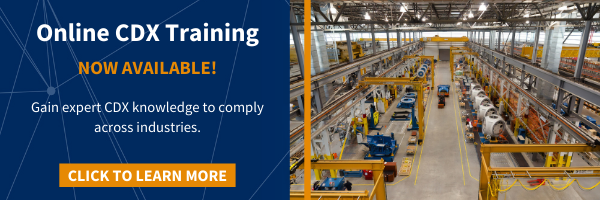With non-automotive materials compliance becoming a more common requirement, many companies who have previously not had to report materials data are finding themselves faced with the daunting task of meeting new requirements. This task is only made more challenging by the lack of a centralized data system for non-automotive materials data along with requirements that may differ from customer to customer.
If you manufacture components that are used in non-automotive assemblies, you have likely heard buzz about new materials data requirements. In this article, we’ll help you understand what you may be required to report as well as how you can best start this reporting process.
Defining Non-Automotive Components
While there is no official definition for non-automotive components, for the purposes of this article we will use the term to mean any vehicle and/or component that does not allow for IMDS (International Material Data System) data entry per the IMDS Terms of Use. This encompasses the materials, parts and assemblies incorporated into any product other than “passenger vehicles.” For more precise information, refer to the IMDS Terms of Use and the European Union’s End of Life Vehicles (ELV) Directive.
This definition is still only approximate because there are certain provisions for non-passenger vehicle components (i.e. commercial vehicles and recreational vehicles) and other products that may fall under the Terms of Use of IMDS. For the sake of convenience, the definition we will use in this article will apply to most makers of boats, bulldozers, cranes, large trucks and other original equipment manufacturers (OEMs) who produce assemblies from components and materials that may be used in automobiles but are also used in other industries.
Is Materials Compliance Data Required for Non-Automotive Components?
Whether or not you are required to report compliance data for your non-automotive components can be a complex question. It is best addressed by distinguishing three different situations:
-
- Legal Requirements
- Customer (Contractual) Requirements
- Industry Best Practices
Legal Obligations
If your company has a legal obligation to provide materials compliance data, then the answer is definite: Yes, you must report materials data. Failing to do so will result in noncompliance.
Customer Requirements
If your customer is asking for the data, and it is spelled out in the delivery contract, then you must also provide that data. You signed up for the requirement, even if it is not a direct legal requirement for you. You would be subject to various contractual liabilities if you fail to deliver the data.
On the other hand, if the customer is asking for the data but has never formally incorporated it into your scope of work, the answer is not quite as clear. Strictly speaking, it might not be a requirement for you to report the data, but you would be disappointing a customer who needs the data which may create problems for you.
Industry Best Practices
It is also important to consider the industry best practices when answering this question. Materials compliance reporting is becoming an expectation across many industries. An increasing number of companies are reporting their data and asking their suppliers to do so as well.
As materials compliance becomes a norm, stakeholders such as customers, supply chains, regulators, consumers and investors may be interested in you participating in materials compliance reporting in order to ensure that the company is conducting its due diligence and limiting its environmental liabilities.
Steps for Understanding Non-Automotive Compliance Requirements
Understand Your Legal Requirements
When looking to meet materials reporting requirements for non-automotive components, you should first understand your legal obligations. As stated above, complying with the law is not optional, so you should assess which material content reporting requirements exist in your products’ markets.
For example, although the EU’s ELV directive only applies to passenger vehicles, there are other pieces of legislation that may require you to report non-automotive component materials if you are exporting them to Europe. These can include REACH (Registration, Evaluation, Authorisation and Restriction of Chemicals), SCIP (Substances of Concern in Products), WEEE (Waste from Electrical and Electronic Equipment) and RoHS (Restriction of Hazardous Substances).
There are also requirements you may be subject to in North America. These can include California Prop 65 and CEPA (Canadian Environmental Protection Act).
Understand Your Customer Requirements
In addition to understanding your legal requirements, you will also need to understand your customer requirements. Rather than wait for your customer to reach out to you, it would be better to be proactive in understanding what the materials compliance requirements are now and what they will be in the future.
If these requirements have already been codified in contractual terms and conditions, then you have an existing requirement to report. If they have not been formally incorporated into the scope of work, it may be coming your way soon given the proliferation of new materials compliance requirements your customers may face.
Understand What Your Competitors Are Doing
Finally, start to understand what your competitors are doing. Is it now becoming customary to report materials content in your industry sector? Are your competitors surveying their supply chain? Are they purchasing reporting software and/or modifying their existing software to collect and report material data? What approaches are they taking and what is most (and least) successful?
Many industry organizations have committees that focus directly on materials content reporting and these may be the perfect venue for having these discussions.
Understanding what others in your industry are doing will help you set your expectations and take the next steps to establishing a materials reporting system that best works for you.
Building a Non-Automotive Materials Content Reporting Program
Without a system in place to collect and evaluate the content of your purchased components, you will not really know what requirements affect you and what liabilities you are taking on by placing products onto the market in various jurisdictions. Knowing what is in the parts you sell is essential to exercising due diligence and protecting against liabilities. The need for this will only grow and scale with your market presence across multiple jurisdictions.
To implement a reporting program for your non-automotive materials data, there are several steps to take:
-
- Evaluate your near-term exposure to environmental compliance liabilities within the jurisdictions when you intend to place vehicles on the market.
- Decide which tools are most cost effective and efficient for collecting and reporting data for compliance within those jurisdictions. These can include CDX, iPoint, Assent, Dassault or other options.
- Draft a plan for data collection and reporting. This will mitigate your financial risks, risks to brand reputation and/or your ability to meet contractual requirements.
- Evaluate your near-term exposure to environmental compliance liabilities within the jurisdictions when you intend to place vehicles on the market.

Get Non-Automotive Compliance Support
If your company faces a significant materials compliance reporting requirement, it may be time to look at a long-term solution that enables your supply chain to report to you in a timely manner. This evaluation may include surveying, educating and communicating with your suppliers. It may also include looking for the best data management approach and software tools.
For assistance on evaluating approaches to address your non-automotive materials compliance needs, contact Tetra Tech’s compliance experts. We provide assessments for all types of non-automotive companies and can assist you with any aspect of your compliance program.






